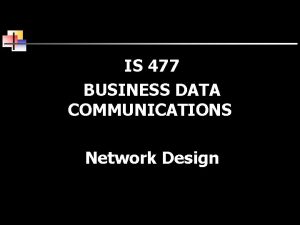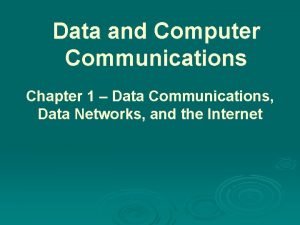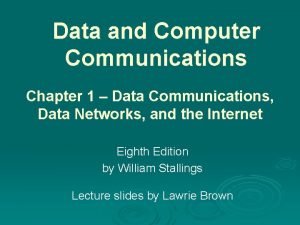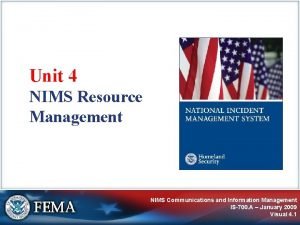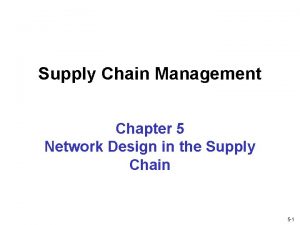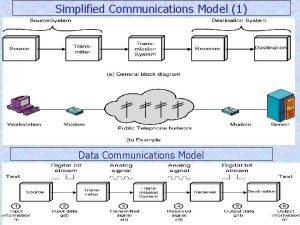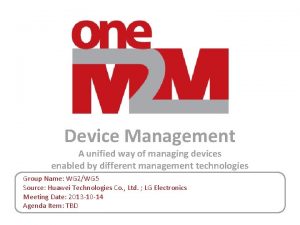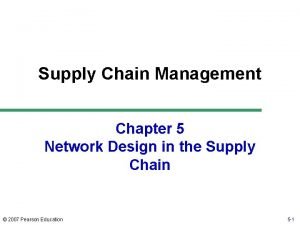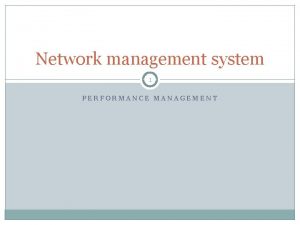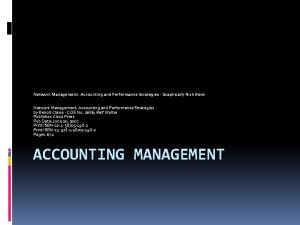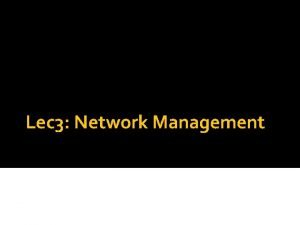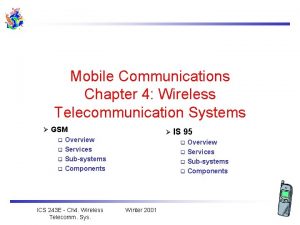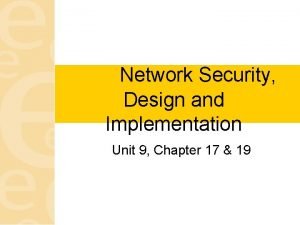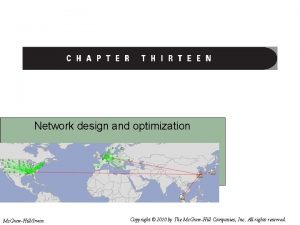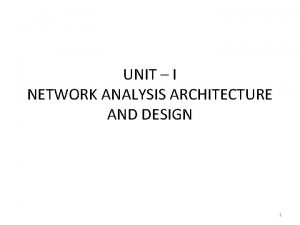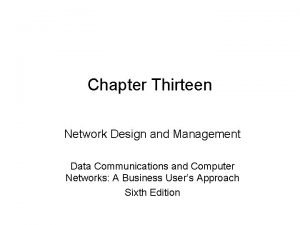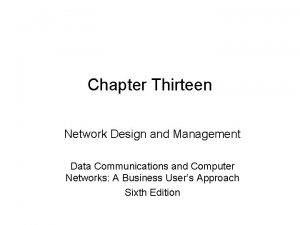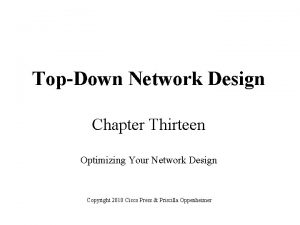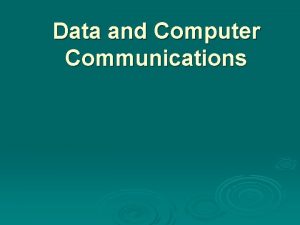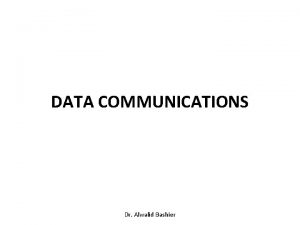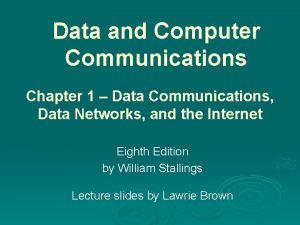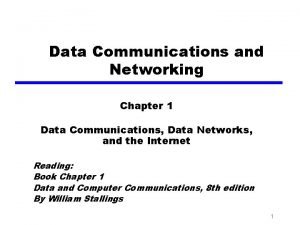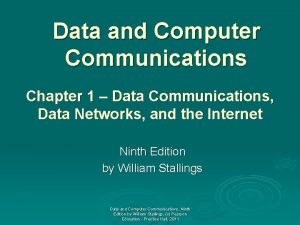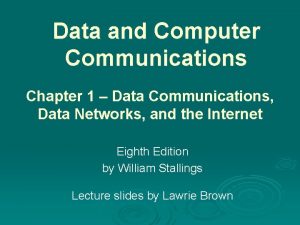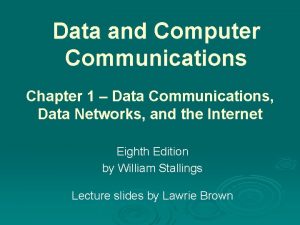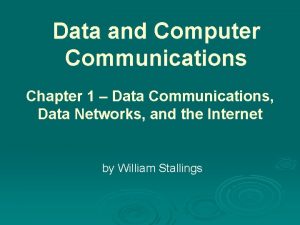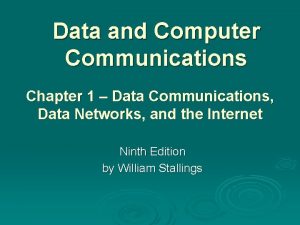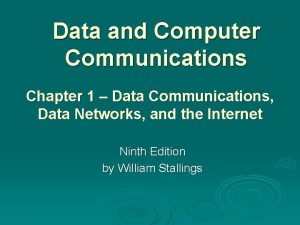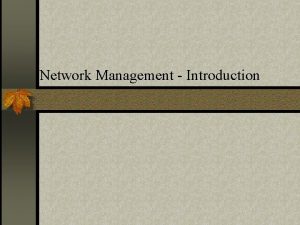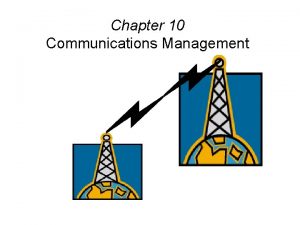Chapter Thirteen Network Design and Management Data Communications


















































- Slides: 50

Chapter Thirteen Network Design and Management Data Communications and Computer Networks: A Business User’s Approach Eighth Edition

After reading this chapter, you should be able to: • Recognize the systems development life cycle and define each of its phases • Explain the importance of creating one or more connectivity maps • Outline the differences among technical, financial, operational, and time feasibility • Create a cost-benefit analysis incorporating the time value of money • Explain why performing capacity planning and traffic analysis is difficult Data Communications and Computer Networks: A Business User's Approach, Eighth Edition © 2016. Cengage Learning. All Rights Reserved. 2

After reading this chapter, you should be able to (continued): • Describe the steps involved in performing a baseline study • Discuss the importance of a network administrator and the skills required for that position • Calculate component and system reliability and availability • Recognize the basic hardware and software network diagnostic tools • Describe the importance of a help desk with respect to managing network operations Data Communications and Computer Networks: A Business User's Approach, Eighth Edition © 2016. Cengage Learning. All Rights Reserved. 3

After reading this chapter, you should be able to (continued): • List the main features of the Simple Network Management Protocol (SNMP) and distinguish between a manager and an agent • Describe the use of the Remote Network Monitoring (RMON) protocol and its relationship to SNMP Data Communications and Computer Networks: A Business User's Approach, Eighth Edition © 2016. Cengage Learning. All Rights Reserved. 4

Introduction • Properly designing a computer network is difficult task – It requires planning and analysis, feasibility studies, capacity planning, and baseline creation skills • Performing network management is difficult too – Network manager must possess computer and people skills, management skills, financial skills, and be able to keep up with changing technology Data Communications and Computer Networks: A Business User's Approach, Eighth Edition © 2016. Cengage Learning. All Rights Reserved. 5

Systems Development Life Cycle • Every business has number of goals – System planners and management personnel within company try to generate set of questions, or problems, to help company achieve those goals • To properly understand a problem, analyze all possible solutions, select the best solution, and implement and maintain the solution, you need to follow a well-defined plan – SDLC is a methodology, or plan, for a structured approach to the development of a business system Data Communications and Computer Networks: A Business User's Approach, Eighth Edition © 2016. Cengage Learning. All Rights Reserved. 6

Systems Development Life Cycle (continued) • SDLC involves several phases which are: – Planning – Analysis – Design – Implementation – Maintenance • These phases are cyclical and usually neverending Data Communications and Computer Networks: A Business User's Approach, Eighth Edition © 2016. Cengage Learning. All Rights Reserved. 7

Systems Development Life Cycle (continued) Data Communications and Computer Networks: A Business User's Approach, Eighth Edition © 2016. Cengage Learning. All Rights Reserved. 8

Systems Development Life Cycle (continued) • Systems analyst is typically responsible for managing a project and following the SDLC phases • Anyone, however, may be called upon to assist a systems analyst – Or anyone may have to assume some duties of systems analyst • Individuals that are called upon to support a computer network should understand basic phases of SDLC Data Communications and Computer Networks: A Business User's Approach, Eighth Edition © 2016. Cengage Learning. All Rights Reserved. 9

Systems Development Life Cycle (continued) • Planning Phase – Identify problems, opportunities, and objectives • Analysis Phase – Determine information requirements – Information requirements can be gathered by sampling and collecting hard data, interviewing, questionnaires, observing environments, and prototyping • Design Phase – Design the system that was recommended and approved at the end of the analysis phase Data Communications and Computer Networks: A Business User's Approach, Eighth Edition © 2016. Cengage Learning. All Rights Reserved. 10

Systems Development Life Cycle (continued) • Implementation Phase – The system is installed and preparations are made to move from the old system to the new • Maintenance Phase – The longest phase, involves the ongoing maintenance of the project – May require personnel to return to an earlier phase to perform an update Data Communications and Computer Networks: A Business User's Approach, Eighth Edition © 2016. Cengage Learning. All Rights Reserved. 11

Network Modeling • When updating or creating a new computer system, analyst will create set of models for both existing system and proposed system • Network models can either: – Demonstrate current state of network – Model desired computer network • Series of connectivity maps are network modeling tools that depict various locations involved over wide and local areas and interconnections between those locations Data Communications and Computer Networks: A Business User's Approach, Eighth Edition © 2016. Cengage Learning. All Rights Reserved. 12

Wide Area Connectivity Map • Shows big picture of geographic locations of network facilities • External users and mobile users can be identified, as well as the locations primary to a business Data Communications and Computer Networks: A Business User's Approach, Eighth Edition © 2016. Cengage Learning. All Rights Reserved. 13

Wide Area Connectivity Map (continued) • To identify each connection between sites: – d = distance of the connection (usually shown in either miles or kilometers) – s = security level (high, medium, low, or none) – du = duplexity (full duplex, half duplex, or simplex) – dr = data rate desired (in bps) – l = latency, or acceptable delay time across the network (usually in milliseconds, or ms) – Qo. S = Quality of Service • CBR - constant bit rate, VBR - variable bit rate, ABR available bit rate, UBR - unreliable bit rate, or none – de = delivery rate (sometimes called throughput percentage) Data Communications and Computer Networks: A Business User's Approach, Eighth Edition © 2016. Cengage Learning. All Rights Reserved. 14

Wide Area Connectivity Map (continued) Data Communications and Computer Networks: A Business User's Approach, Eighth Edition © 2016. Cengage Learning. All Rights Reserved. 15

Wide Area Connectivity Map (continued) • Connection from L. A. to Chicago might be: – d = 2250 miles – s = medium – du = full – dr = 256 kbps – l = 200 ms – Qo. S = ABR – de = 99. 9% Data Communications and Computer Networks: A Business User's Approach, Eighth Edition © 2016. Cengage Learning. All Rights Reserved. 16

Wide Area Connectivity Map (continued) Data Communications and Computer Networks: A Business User's Approach, Eighth Edition © 2016. Cengage Learning. All Rights Reserved. 17

Metropolitan Area Connectivity Map • Shows the design of a metropolitan area and its network facilities. • Qo. S = VBR • dr = 100 Mbps • s = high • d = 5 km • failover = 50 ms • de = 99. 9% Data Communications and Computer Networks: A Business User's Approach, Eighth Edition © 2016. Cengage Learning. All Rights Reserved. 18

Metropolitan Area Connectivity Map (continued) Data Communications and Computer Networks: A Business User's Approach, Eighth Edition © 2016. Cengage Learning. All Rights Reserved. 19

Local Area Connectivity Map • Local area overview connectivity map – shows the big picture design of a local area network – Qo. S = none – dr = 100 Mbps – s = none – d = 85 m – du = full – thru = 50% Data Communications and Computer Networks: A Business User's Approach, Eighth Edition © 2016. Cengage Learning. All Rights Reserved. 20

Local Area Connectivity Map (continued) Data Communications and Computer Networks: A Business User's Approach, Eighth Edition © 2016. Cengage Learning. All Rights Reserved. 21

Local Area Connectivity Map (continued) • Local area detailed connectivity map – shows the close-up design of a local area network, including switches, routers, hubs, and servers – Much like the homework we did earlier showing LAN connections Data Communications and Computer Networks: A Business User's Approach, Eighth Edition © 2016. Cengage Learning. All Rights Reserved. 22

Local Area Connectivity Map (continued) Data Communications and Computer Networks: A Business User's Approach, Eighth Edition © 2016. Cengage Learning. All Rights Reserved. 23

Feasibility Studies • There a number of ways to determine if a proposed system is going to be feasible • Technically feasible – proposed system can be created and implemented using currently existing technology • Financially feasible – proposed system can be built given the company’s current financial ability • Operationally feasible – system operates as designed and implemented Data Communications and Computer Networks: A Business User's Approach, Eighth Edition © 2016. Cengage Learning. All Rights Reserved. 24

Feasibility Studies (continued) • Time feasible – system can be constructed in an agreed upon time frame • Payback analysis is good technique to use to determine financial feasibility – To calculate payback analysis, you must know all expenses that will be incurred to create and maintain system, as well as all possible income derived from system – You must also be aware of time value of money • A dollar today is worth more than one dollar promised a year from now because dollar can be invested Data Communications and Computer Networks: A Business User's Approach, Eighth Edition © 2016. Cengage Learning. All Rights Reserved. 25

Feasibility Studies (continued) Data Communications and Computer Networks: A Business User's Approach, Eighth Edition © 2016. Cengage Learning. All Rights Reserved. 26

Feasibility Studies (continued) 27

Capacity Planning • Involves trying to determine the amount of network bandwidth necessary to support an application or a set of applications • A number of techniques exist for performing capacity planning, including linear projection, computer simulation, benchmarking, and analytical modeling • Linear projection involves predicting one or more network capacities based on the current network parameters and multiplying by some constant Data Communications and Computer Networks: A Business User's Approach, Eighth Edition © 2016. Cengage Learning. All Rights Reserved. 28

Capacity Planning (continued) • A computer simulation involves modeling an existing system or proposed system using a computer-based simulation tool • Benchmarking involves generating system statistics under a controlled environment and then comparing those statistics against known measurements • Analytical modeling involves the creation of mathematical equations to calculate various network values Data Communications and Computer Networks: A Business User's Approach, Eighth Edition © 2016. Cengage Learning. All Rights Reserved. 29

Creating a Baseline • Involves measurement and recording of a network’s state of operation over given period of time • Baseline can be used to determine current network performance and to help determine future network needs • Baseline studies should be ongoing projects, and not something started and stopped every so many years Data Communications and Computer Networks: A Business User's Approach, Eighth Edition © 2016. Cengage Learning. All Rights Reserved. 30

Creating a Baseline (continued) • To perform a baseline study, you should: – Collect information on number and type of system nodes, including workstations, routers, bridges, switches, hubs, and servers – Create an up-to-date roadmap of all nodes along with model numbers, serial numbers and any address information such as IP or Ethernet addresses – Collect information on operational protocols used throughout the system Data Communications and Computer Networks: A Business User's Approach, Eighth Edition © 2016. Cengage Learning. All Rights Reserved. 31

Creating a Baseline (continued) • To perform a baseline study, you should: (continued) – List all network applications, including the number, type and utilization level – Create a fairly extensive list of statistics to help meet your goals • These statistics can include average network utilization, peak network utilization, average frame size, peak frame size, average frames per second, peak frames per second, total network collisions, network collisions per second, total runts, total jabbers, total CRC errors, and nodes with highest percentage of utilization Data Communications and Computer Networks: A Business User's Approach, Eighth Edition © 2016. Cengage Learning. All Rights Reserved. 32

Creating a Baseline (continued) Data Communications and Computer Networks: A Business User's Approach, Eighth Edition © 2016. Cengage Learning. All Rights Reserved. 33

Network Administrator Skills • A good network manager will possess many skills: – Computer skills – People skills – Management skills – Financial planning skills – Knowledge of statistics – Speaking and writing skills Data Communications and Computer Networks: A Business User's Approach, Eighth Edition © 2016. Cengage Learning. All Rights Reserved. 34

Network Administrator Skills (continued) • A good network manager will possess one or more certifications: – Microsoft Certified Solutions Associate (MCSA) – Cisco Certified Network Associate (CCNA) – IBM Certified Systems Expert (CSE) – And others Data Communications and Computer Networks: A Business User's Approach, Eighth Edition © 2016. Cengage Learning. All Rights Reserved. 35

Generating Usable Statistics • Statistics, properly generated, can be an invaluable aid to demonstrating current system demands and predicting future needs • Mean time between failures (MTBF) – average time a device or system will operate before it fails • Mean time to repair (MTTR) – average time necessary to repair a failure within the computer system Data Communications and Computer Networks: A Business User's Approach, Eighth Edition © 2016. Cengage Learning. All Rights Reserved. 36

Generating Usable Statistics (continued) • Availability – probability that a particular component or system will be available during a fixed time period • Availability % = (Total available time – Downtime) / Total available time Data Communications and Computer Networks: A Business User's Approach, Eighth Edition © 2016. Cengage Learning. All Rights Reserved. 37

Generating Usable Statistics (continued) • Suppose we want to calculate the availability of a modem for one month (24 hours per day for 30 days, or 720 hours), knowing the modem will be down for two hours during that period: – Availability % = (720 – 2) / 720 = 0. 997 Data Communications and Computer Networks: A Business User's Approach, Eighth Edition © 2016. Cengage Learning. All Rights Reserved. 38

Generating Usable Statistics (continued) • Reliability is defined by the equation: R(t) = e -bt In which: b = 1/MTBF t = the time interval of the operation Data Communications and Computer Networks: A Business User's Approach, Eighth Edition © 2016. Cengage Learning. All Rights Reserved. 39

Generating Usable Statistics (continued) • What is the reliability of a modem if the MTBF is 3000 hours and a transaction takes 20 minutes, or 1/3 of an hour (0. 333 hours): R(0. 333 hours) = e -(1/3000)*(0. 333) = e -0. 000111 = 0. 99989 Data Communications and Computer Networks: A Business User's Approach, Eighth Edition © 2016. Cengage Learning. All Rights Reserved. 40

Managing Operations • There are many services and functions available to assist an individual in managing computer network operations – One of the more useful is Simple Network Management Protocol (SNMP) • SNMP is industry standard designed to manage network components from a remote location – Currently in version 3, SNMP supports agents, managers, and the Management Information Base (MIB) Data Communications and Computer Networks: A Business User's Approach, Eighth Edition © 2016. Cengage Learning. All Rights Reserved. 41

Managing Operations (continued) • A managed element has management software, called an agent, running in it • A second object, SNMP manager, controls operations of a managed element and maintains a database of information about all managed elements • A manager can query an agent to return current operating values, or can instruct an agent to perform a particular action • Management Information Base (MIB) – collection of information that is organized hierarchically and describes the operating parameters of all managed agents Data Communications and Computer Networks: A Business User's Approach, Eighth Edition © 2016. Cengage Learning. All Rights Reserved. 42

Network Diagnostic Tools • To assist a network support person, a number of diagnostic tools are available: – Electrical testers – Cable testers – Network testers – Protocol analyzers Data Communications and Computer Networks: A Business User's Approach, Eighth Edition © 2016. Cengage Learning. All Rights Reserved. 43

Capacity Planning and Network Design In Action: Better Box Corporation • Returning to Better Box Corporation from an earlier chapter, let’s complete our design, including e-mail and Internet access for each of the four sites • A linear projection can be used to estimate the amount of Internet traffic at each site • A wide area connectivity map gives us a big picture of the network interconnections Data Communications and Computer Networks: A Business User's Approach, Eighth Edition © 2016. Cengage Learning. All Rights Reserved. 44

Capacity Planning and Network Design In Action: Better Box Corporation (continued) Data Communications and Computer Networks: A Business User's Approach, Eighth Edition © 2016. Cengage Learning. All Rights Reserved. 45

Capacity Planning and Network Design In Action: Better Box Corporation (continued) • A second linear projection can be used to determine the amount of local area network traffic within each site Data Communications and Computer Networks: A Business User's Approach, Eighth Edition © 2016. Cengage Learning. All Rights Reserved. 46

Capacity Planning and Network Design In Action: Better Box Corporation (continued) Data Communications and Computer Networks: A Business User's Approach, Eighth Edition © 2016. Cengage Learning. All Rights Reserved. 47

Summary • When creating new network or adding to existing network, there are many potential pitfalls and opportunities for inaccurate and incomplete assessments • SDLC is one of the most popular techniques used to guide analysts through difficult decision-making process of network design • Persons designing new network or upgrading existing network may want to create one or more network models to help visualize the system • An important part of SDLC is conducting of one or more feasibility studies Data Communications and Computer Networks: A Business User's Approach, Eighth Edition © 2016. Cengage Learning. All Rights Reserved. 48

Summary (continued) • Payback analysis is one possible financial analysis technique that can be applied to proposed computer network system to determine system’s costs and benefits • Capacity planning is necessary technique that enables network administrator to determine network bandwidth needed to support one or more applications within a business • A baseline study involves measuring and recording of network’s state of operation over a given period of time • Once a network is in operation, good network management is necessary to keep network operating at peak efficiency Data Communications and Computer Networks: A Business User's Approach, Eighth Edition © 2016. Cengage Learning. All Rights Reserved. 49

Summary (continued) • Network administrator should be able to create and use basic statistics • A large variety of diagnostic tools are available that can aid network personnel in troubleshooting and maintaining common complex computer networks • All networks need a command center • The Simple Network Management Protocol (SNMP) helps network support personnel monitor network performance, find network problems, and then solve those problems without physically touching the affected device Data Communications and Computer Networks: A Business User's Approach, Eighth Edition © 2016. Cengage Learning. All Rights Reserved. 50
 Chapter 3 network protocols and communications
Chapter 3 network protocols and communications Communications network design
Communications network design Comparing and contrasting the 13 colonies
Comparing and contrasting the 13 colonies Original thirteen colonies
Original thirteen colonies One two three four five six numbers
One two three four five six numbers 13 ways of seeing nature in la
13 ways of seeing nature in la Rule of thirteen mass spectrometry
Rule of thirteen mass spectrometry Freddy the thirteen
Freddy the thirteen Thirteen colonies
Thirteen colonies Thirteen dogs
Thirteen dogs Alabama alaska arizona arkansas
Alabama alaska arizona arkansas Brainpop roanoke
Brainpop roanoke Thirteen apostles
Thirteen apostles New concept english 3
New concept english 3 Network systems design using network processors
Network systems design using network processors Network design and management
Network design and management Telecommunications and data communications
Telecommunications and data communications Data and computer communications 10th edition
Data and computer communications 10th edition Data and computer communication
Data and computer communication Business data communications and networking
Business data communications and networking Business data communication and networking
Business data communication and networking Data and computer communications
Data and computer communications Introduction to data communications and networking
Introduction to data communications and networking William stallings data and computer communications
William stallings data and computer communications Business data communications and networking
Business data communications and networking Track and report nims
Track and report nims Chapter 4 communications and documentation
Chapter 4 communications and documentation Supply chain management network design
Supply chain management network design Data communication model with diagram
Data communication model with diagram Introduction to data communications
Introduction to data communications Moinstance
Moinstance Tailored network
Tailored network Network performance management system
Network performance management system Network accounting management
Network accounting management Public switched telephone network notes
Public switched telephone network notes Network management definition
Network management definition Datagram networks
Datagram networks Features of peer to peer network and client server network
Features of peer to peer network and client server network Network centric computing and network centric content
Network centric computing and network centric content A fire department communication center functions
A fire department communication center functions Communications chapter
Communications chapter What is topology in computer
What is topology in computer Packet switching vs circuit switching شرح
Packet switching vs circuit switching شرح Network design and construction
Network design and construction Network design and implementation
Network design and implementation Network design and optimization
Network design and optimization Network analysis architecture and design
Network analysis architecture and design Top down network design
Top down network design Input output and form design
Input output and form design Orient east med corridor
Orient east med corridor Global marketing and communications
Global marketing and communications

